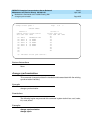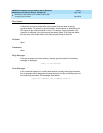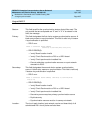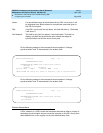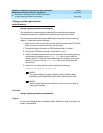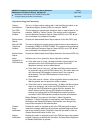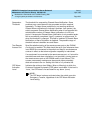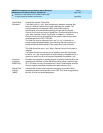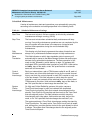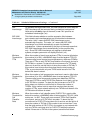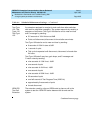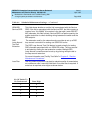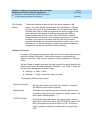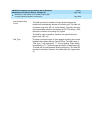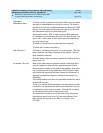
DEFINITY Enterprise Communications Server Release 5
Maintenance and Test for R5vs/si
555-230-123
Issue 1
April 1997
Maintenance Commands and Trouble-Clearing Aids
Page 8-63change system-parameters maintenance
8
Scheduled Maintenance
A series of maintenance tests and operations runs automatically every day
according to the schedule and settings specified in the following fields
Table 8-1. Scheduled Maintenance Settings
Start Time The hour and minute in 24-hour notation at which daily scheduled
maintenance will begin running. (22:00)
Stop Time The hour and minute when scheduled daily maintenance will stop
running. If any daily maintenance operations are not completed by this
time, the system will note where in the sequence it stopped and
perform those operations during the next scheduled daily
maintenance.
Daily
Maintenance
This display-only field simply represents the series of tests that are
always run by maintenance software as part of daily maintenance.
Save
Translation
This field indicates on which days translation data in memory will
automatically be saved to the Mass Storage System disk and/or tape
devices during scheduled maintenance. The save operation is first
made to disk, followed by a disk backup to tape. On systems with
duplicated SPEs, translation data is saved on both SPEs. Valid entries
are daily, days of the week, or no. "No" specifies that no automatic
saves are to be executed.
Control
Channel
Interchange
Each port network has a pair of TDM busses called A and B, each of
which has a set of time slots dedicated to use by the control channel.
At any one time, the control channel in each PN is carried on only one
of the two busses. This field indicates on which days the control
channel in each port network will be switched from one of the paired
TDM busses to the other. Valid entries are daily, days of the week, or
no. "No" specifies that no interchange be executed. (no)
System
Clocks
Interchange
On High and Critical Reliability systems, this option causes a
Tone-Clock interchange in each port network with duplicated
Tone-Clock circuit packs. Each port network interchanges into the
standby Tone-Clock for 20 seconds and then back to the Tone-Clock
that was originally active. This field indicates on which days the
interchanges are to take place. Valid entries are daily, days of the
week, or no. "No" specifies that interchanges be executed. (no)
The system performs a Tone-Clock interchange, making the stand by
Tone-Clock active. The newly active Tone-Clock circuit pack is tested
and, while active, provides system clocks for the port network in which
it resides. The system then interchanges back to the originally active
Tone-Clock circuit pack.
Continued on next page



